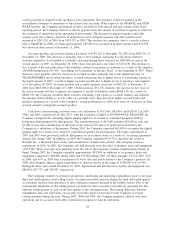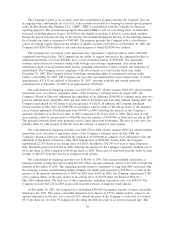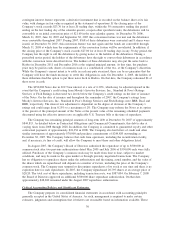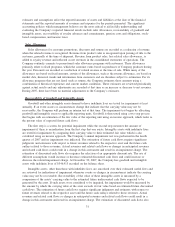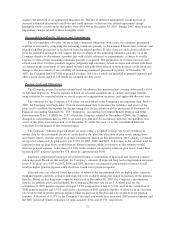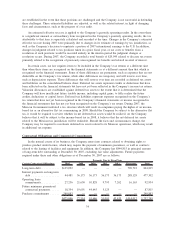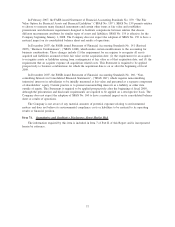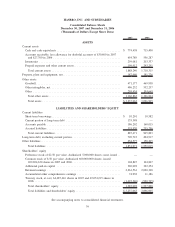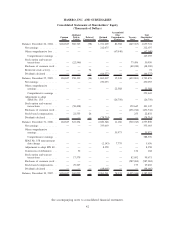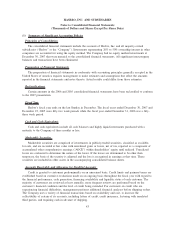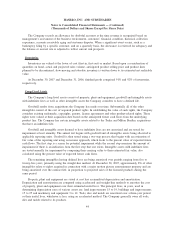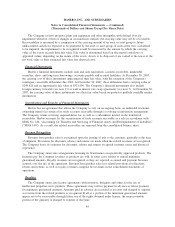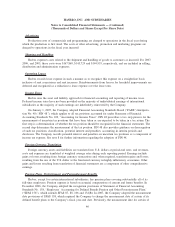Hasbro 2007 Annual Report Download - page 44
Download and view the complete annual report
Please find page 44 of the 2007 Hasbro annual report below. You can navigate through the pages in the report by either clicking on the pages listed below, or by using the keyword search tool below to find specific information within the annual report.
December 30, 2007, these contracts had a fair value of $256, which was included in other current assets, with
a corresponding fair value adjustment to increase the current portion of long-term debt. Changes in interest
rates affect the fair value of fixed rate debt not hedged by interest rate swap agreements while affecting the
earnings and cash flows of the long-term debt hedged by the interest rate swaps. The Company estimates that
a hypothetical one percentage point decrease or increase in interest rates would increase or decrease the fair
value of this long-term debt by approximately $39,500 or $35,400, respectively. A hypothetical one percentage
point change in interest rates would increase or decrease 2008 pretax earnings and cash flows by $379 and
$379, respectively.
The Economy and Inflation
The principal market for the Company’s products is the retail sector. Revenues from the Company’s top 5
customers, all retailers, accounted for approximately 52%, 53%, and 53% of its consolidated net revenues in
2007, 2006 and 2005, respectively. In the past three years certain customers in the retail sector have
experienced economic difficulty. The Company monitors the creditworthiness of its customers and adjusts
credit policies and limits as it deems appropriate.
The Company’s revenue pattern continues to show the second half of the year to be more significant to
its overall business for the full year. In 2007, approximately 66% of the Company’s full year net revenues
were recognized in the second half of the year. Although the Company expects that this concentration will
continue, particularly as more of its business has shifted to larger customers with order patterns concentrated
in the second half of the year, this concentration may be less in years where the Company has products related
to a major motion picture release that occurs in the first half of the year. In 2007, the Company had products
related to two major motion picture releases, SPIDER-MAN 3 in May of 2007 and TRANSFORMERS in July
of 2007. The concentration of sales in the second half of the year increases the risk of (a) underproduction of
popular items, (b) overproduction of less popular items, and (c) failure to achieve tight and compressed
shipping schedules. The business of the Company is characterized by customer order patterns which vary from
year to year largely because of differences in the degree of consumer acceptance of a product line, product
availability, marketing strategies, inventory levels, policies of retailers and differences in overall economic
conditions. The trend of larger retailers has been to maintain lower inventories throughout the year and
purchase a greater percentage of product within or close to the fourth quarter holiday consumer selling season,
which includes Christmas.
Quick response inventory management practices being used by retailers result in more orders being placed
for immediate delivery and fewer orders being placed well in advance of shipment. Retailers are timing their
orders so that they are being filled by suppliers closer to the time of purchase by consumers. To the extent that
retailers do not sell as much of their year-end inventory purchases during this holiday selling season as they
had anticipated, their demand for additional product earlier in the following fiscal year may be curtailed, thus
negatively impacting the Company’s revenues. In addition, the bankruptcy or other lack of success of one of
the Company’s significant retailers could negatively impact the Company’s future revenues.
The effect of inflation on the Company’s operations during 2007 was not significant and the Company
will continue its policy of monitoring costs and adjusting prices, accordingly.
Other Information
In September 2006, the FASB issued Statement of Financial Accounting Standards No. 157, “Fair Value
Measurements”, (“SFAS No. 157”) which defines fair value, establishes a framework for measuring fair value
in generally accepted accounting principles and expands disclosures about fair value measurements.
SFAS No. 157 is applicable for the Company as of December 31, 2007, the first day of fiscal 2008. The FASB
issued FASB Staff Position FAS 157-b, “Effective Date of FASB Statement No. 157”, which deferred the
effective date of the Statement for certain nonfinancial assets and liabilities until fiscal 2009. The Company
does not expect the adoption of SFAS No. 157 to have a material impact on its consolidated balance sheet and
results of operations.
36




